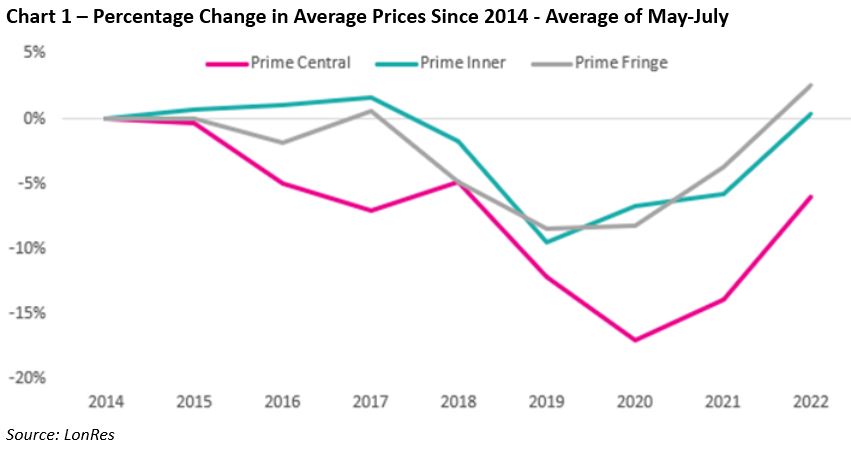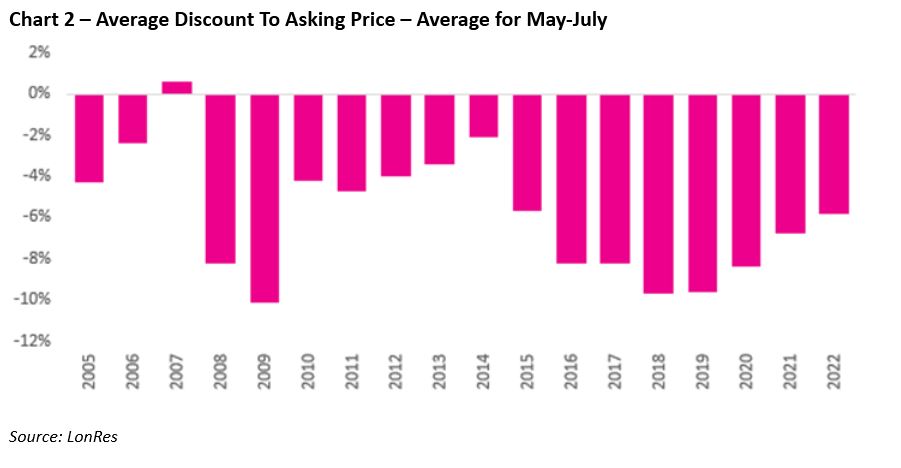
LonRes has published its latest analysis of the property market in the prime areas of Central London.
Anthony Payne, Managing Director of LonRes introduced the report:
“Despite rising concerns about the state of the wider economy, the Prime London market is in good health.
“During July activity levels in Prime London were above pre-pandemic levels. Sales in July were 9.8% higher than their 2017-19 average and prices were 4.2% up (table 1).
“Meanwhile new instructions remain firmly higher than their pre-pandemic average (22.6%).”
The years leading up to the pandemic (2017-19) saw both demand and prices fall across prime central and the wider prime London housing markets. But in a reversal of fortunes the capital’s prime markets have been steadily recovering.
Property prices are still rising amidst a lack of stock (new instructions rose by just 4.7% over July compared to July last year) and continued demand from buyers. While year-on-year transactions (properties sold) across Prime London in July increased by over 43% (table 1).
While this partly reflects last year’s post-stamp duty holiday trough, there is no sign of a post-holiday hangover at the top-end of the market (£5m+) which is still recording high levels of sales. There were 3.9% more sales of £5m+ properties in the year to July 2022 than at the previous peak in 2014. This in turn has helped push prices back towards peak levels recorded in the years prior to Covid.
Prices across wider Prime London were just 2% lower in May-July 2022 than at the same period in 2014. And in some markets are now higher. In Prime Fringe prices between May and July this year were 2.6% higher than they were between May and July in 2014.
However, not all markets have recovered and in Prime Central London prices are still 6% lower than eight years ago. That said even here prices have recovered from the lows recorded during the pandemic.
Buyer and seller expectations align
As prices return to their previous peaks, the pricing expectations of sellers and buyers have come closer together.
As chart 2 shows, the average discount to asking prices hit 10% in 2018 and 2019 – similar to the discount recorded during the depths of the financial crisis in 2009. But, alongside the recovery in prices and activity levels, the average discount has narrowed in recent years.
The average discount across Prime London was just 5.8% recorded in May-July 2022 – similar to the 5.7% recorded during the same period in 2015.
However, as table 2 shows, the average discount varies by area and property type. The discount to asking price ratio is biggest in Prime Central London (7.3%) and smallest in Prime Fringe London (4.8). Similarly, the discount for flats (6.2%) is bigger than for houses (4.8%), irrespective of the sub-market they’re in. The variation in discount by place and property type partly reflects the relative recoveries in the different prime London markets (chart 1).
Prospective sellers have been proven to show signs of price-anchoring – the price they are willing to sell is closely linked to their expectations of what their home is worth – often set at the peak of pricing. As prices across Prime London return to their previous peaks and discounts to asking prices narrow, this could encourage more potential sellers to list their property for sale in the coming months.
For the time being there appears to be plenty of demand from buyers – the number of properties under offer in July was 39% higher than last year and 53% higher than the pre-pandemic average.

Low stock levels, high demand and increased renewals characterise prime London rental market
“The rental market across Prime London continues to suffer from a combination of low activity and rapidly rising rents. Activity levels, be they new instructions, under offers, or new lets, are still well below normal levels and close to the exceptionally low levels seen during the market lockdown of 2020,” says Anthony Payne.
This continues the reversal of last year’s market as people return to work and city centre living. With limited homes available to rent, many existing tenants are choosing to renew, while new tenants are left to fight over the few remaining properties available to rent. As a consequence, many tenants are finding themselves subject to tougher rental tenancy terms.
Looking ahead, the next few months are traditionally a busy period for the rental market. Much like the sales market, the availability of new properties will be key for both those looking for a home and those involved in the business of letting them out.
Commenting on the findings, Payne said:
“On the face of it, there is a lot to be downbeat about. And yet beyond the backdrop of a cost of living crisis, rising interest rates and a global economic slowdown, London’s prime housing market continues to hold its own. People still want to move home and buying agent’s report demand from Prime London purchasers to be higher than ever.
“The top-end of the market (above £5m+) continues to be buoyant and houses remain the preferred choice. That said flats – particularly those with no outside space – are still struggling to find buyers and their asking prices reflect this.
“It seems as though purchasers have not been put off by rising interest rates. And anecdotally we hear purchasers have factored these in and are buying with their eyes wide open.
“London’s prime rental market is however a completely different story. We have long reported a shortage of stock at a time when demand is on the rise. With no sign of increased stock levels and tenant renewals on the up, it is difficult to know how this particular deadlock is to be resolved.”
The prime areas break down as:
Prime Central London: SW1Y, SW1X, SW1W, SW1A, SW3, SW7, SW10, W1S, W1K, W1J, W8.
Prime Inner London: NW1, NW3, NW8, SW1P, SW1V, W1T, W1H, W1U, W1G, W1W, W2, W11, W14.
Prime Fringe: SE1, SE11, SW4, SW5, SW6, SW11, W4, W6, W9, W10.



